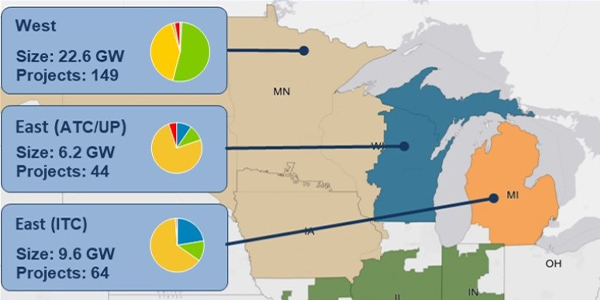By Amanda Durish Cook
Fresh off approval for one change to its interconnection process, MISO is still looking for more ways to advance generation projects more quickly through its queue, stakeholders learned Tuesday.
The RTO put out the renewed call for ideas during an Interconnection Process Working Group (IPWG) meeting that was converted to a conference call as MISO responds to the COVID-19 coronavirus outbreak. (See related story, MISO Steps Up COVID-19 Response.)
MISO is seeking ideas to allow it to simultaneously perform analyses under the definitive planning phase (DPP) and the annual Transmission Expansion Plan, possibly identifying projects that can meet multiple needs. (See MISO Committees Tackle Queue, Tx Planning Disparities.)
“We’re going to strive to improve the process for our customers,” MISO engineer Cody Doll said. “If we’re on the same timeline, we could have common models and joint solution development. … It won’t be a bifurcated effort. It’ll be a coordinated effort between the two functions.”
Doll said he would return to the IPWG in May with more discussion and early proposals. MISO doesn’t yet have a specific target date for when it would file changes to its queue.
It takes just under a year for a proposed generation project to clear the interconnection queue. MISO’s current queue contains 489 projects representing 76.5 GW. Nearly 60% of the projects are proposed solar generation.
“Keep in mind we were over 100 GW after last April’s application deadline,” MISO Manager of Resource Utilization Project Management Jesse Phillips told stakeholders. MISO’s next project application window for the interconnection queue closes June 25. The deadline was extended because of the late April rollout of a new online application tool. (See MISO to Debut Online Queue Requests.)
MISO is also drafting Business Practices Manual language for its new, firmer requirement that project sponsors prove exclusive land use for generation projects entering the queue.
The RTO in December won approval to require interconnection customers to demonstrate 100% site control 90 days before proposed projects enter the first phase of the three-phase DPP of the interconnection queue for study. It also scrapped the previous practice of accepting a $100,000 cash deposit in lieu of demonstrating site control. (See MISO OK’d to Require Site Control in Queue.)
The RTO’s site control land requirements are now 50 acres/MW for wind generation, 5 acres/MW for solar generation, 0.1 acres/MW for battery storage facilities and a standard 10 acres for conventional generating facilities.
MISO has said it will use contractors to help review site control documentation. The cost for project reviews will be charged to customer’s study deposit, similar to other queue study costs. Paul Muncy, of MISO’s transmission access planning division, said the RTO uses contractors for “numerous other project-related studies.”
Muncy said MISO “intends to review site control documentation for each project in order to ensure that no projects are able to take an unfair advantage in proving that they have met all requirements.”
After stakeholder inquiries, Muncy said MISO had more work to do to outline in the BPM what official documentation it will accept as proof of land use. Multiple stakeholders said the style of documentation varies on a county-to-county level and that the RTO’s documentation requirements could be overly burdensome by not accounting for those differences.





